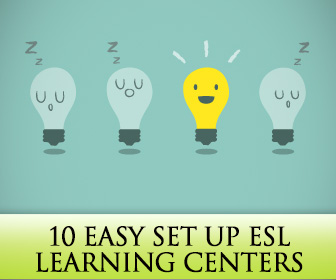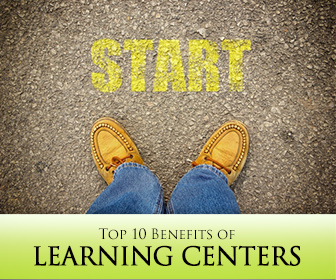10 Easy Set Up Learning Centers for ESL Classrooms


Scattered around the edges of our classroom were simple stations where students could choose their own activities during free learning periods. Some learning centers had art materials, others role playing materials, and others materials that changed as the weeks passed. As I moved on to higher grades, I left the learning centers behind, that is until I started teaching English as a second language, and here’s why.

If you teach several areas of language (and most of us do), you will probably have students who excel in one area (conversation, for example) but struggle in another area (grammar, perhaps). Learning centers are a great opportunity for students to focus in on areas that challenge them. That way, in one class period, you can have some students working on grammar, others on pronunciation, and still others on vocabulary, and everyone is working on the skill they most need to improve. Teachers may not be able to be in several places at one time, but they can walk from learning center to learning center checking in on students and seeing their progress as well as correcting their mistakes.
Sometimes we find that our classes need to repeat lessons because something just isn’t clicking with the class, but what happens to the students who understood it the first time? Students who are already proficient at a certain skill don’t have to sit through whole class lectures or activities on it when they have learning centers they can use during that time. For example, most of your class is struggling with a grammar point you presented yesterday. Those students will benefit from more practice or additional instruction on that topic. Two students, however, have already mastered that skill. In fact, they were already using that structure comfortably when they began classes this semester. While you clarify things for your struggling students, the two students who already get it can use the learning centers. Having this freedom will not only give those two students some new challenge during your class period, it will also keep them more engaged and interested in other class activities they do need. You will find class morale will be higher when all of your students feel every class period is useful for their English education.
Class time is limited, and many requirements fill our calendars quicker than the blink of an eye. Learning centers can be a way to bring new material to your students without taking up additional class time. This is particularly true if you teach multiple groups within one class. While you are working with the beginning students, for example, you might assign your advanced students to complete certain learning center tasks. In these centers, you might make available information you don’t have time to cover with the class. Depending on what subjects you are teaching, you might have newspaper articles for your students to read. You might have a center that teaches idioms or slang expressions that aren’t in your vocabulary book. The material in your centers might go deeper with concepts or language usage – all things you can’t cover during class instruction but still want your students to know.
When you teach a class full of ESL students, it’s difficult to find time to spend with each of them. When your students are working at learning centers around the room, you can check in with each of them, point out any corrections they need to make, or evaluate their performance. This is also an opportunity to pull students aside and clear up any mistakes they may be making on a consistent basis. Holding students after school to clarify a concept can be embarrassing for the student and burdensome for you. When you have students working independently at learning stations, you can have these necessary conversations during class without bringing attention to a student’s performance, and you can make sure each student gets the attention he needs from you.
No group of students will perform at the same level for every task no matter who they are. By offering and assigning learning centers, you can tailor each student’s instruction to his or her needs. Though you may want to allow students to use the centers they prefer, you can also assign certain learning center tasks to specific students in your class. This will give them additional instruction and practice in the areas they need it most. It also allows you to meet specific education goals for each student in your class without derailing your semester’s plans.
Have you ever had a student who just shows up for class but doesn’t participate or engage? I’d like to say I haven’t, but the truth of the matter is some students don’t have the motivation I wish they had. Learning centers are great for engaging this type of student. They get to choose their own activities according to their interests, and they can’t just blend into the back of the class while a lecture happens in the same room. They choose their activity, they complete it, and they don’t sit in the back of the room texting or sleeping.
You probably give your students opportunities to be creative in class, but those opportunities might not be enough for some of your most creative students. The right learning centers can allow your students to express themselves creatively – using art with English or composing creative literature. Not every student is ready to express herself this way, but those who are will reap the benefits from creative expression in education.
Sometimes the pace that most of your students feel comfortable with is not the pace that all of your students feel comfortable with. Some students need more time to understand and absorb information than others. Allowing students to study independently at learning centers lets them go at their own pace. They do not have to complete any activity in a specific amount of time and can take two class periods or more if they need it while other students concentrate on other activities.
One of the easiest learning centers to set up is allowing your students to use materials you used in class activities. These materials might be an object with vocabulary labels (such as a body cut out with labels for the various parts), props for role plays, or anything else you use when you teach your students in class. Making these materials available allows your students to practice and repeat what you did with them in class. Some students need this repetition to truly absorb information. You can also see what activities students enjoyed in class since they are more likely to repeat the ones they liked to begin with. This will also help you tailor your class activities to the personality of your class.
I’m all about fun in the classroom, but keeping spirits and activity levels high all the time can overstimulate students. The right learning centers can provide quiet, calming activities that help your students settle or transition from one activity to another. The key is choosing the right learning centers for your particular class.
You may never have included learning centers in your ESL classes, but you should consider it. They offer many benefits for individual students and allow each person’s education to meet their particular needs. They don’t have to be elaborate or complicated. The hardest part is taking a risk and including them in your classroom. Once you do you are sure to see their benefits.
What benefits do you see coming from it?